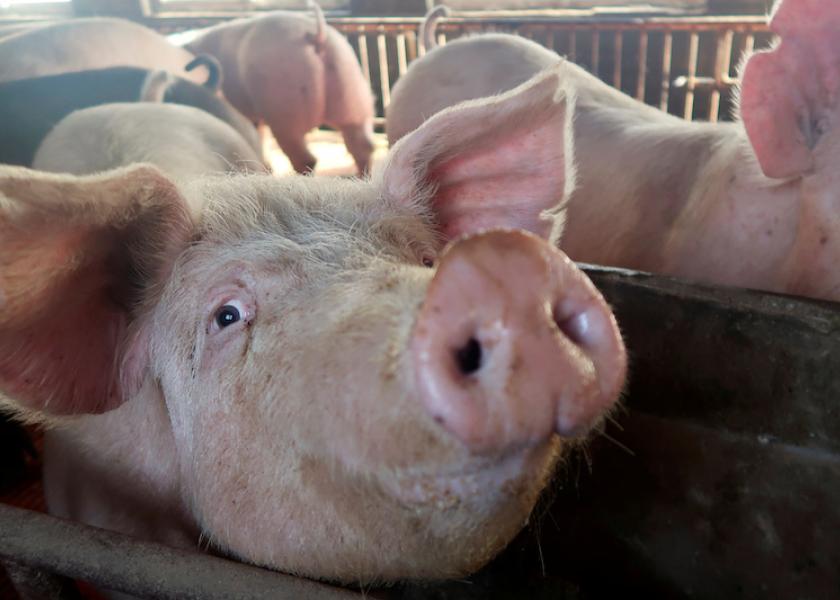Advances in Sampling for More Effective Enteric Disease Control

Producers and veterinarians should “begin with the end in mind” when it comes to diagnosing disease and planning control strategies, according to Eric Burrough, DVM, PhD, associate professor and diagnostic pathologist at the Iowa State Diagnostic Laboratory.
Many common enteric pathogens can be challenging to diagnose, especially as laboratory detection doesn’t always equate to disease diagnosis. However, by creating accurate case definitions and sampling protocols, veterinarians are more likely to successfully detect pathogens and identify treatment options, Burrough said.
There are five elements to managing disease, he said, including case definitions, sampling, appropriate diagnostic testing, interventions and evaluation of treatment outcomes.
“It’s important to begin with the end in mind,” he added, underlining the importance of creating “an accurate case definition and sampling protocol so any detected agent can be properly considered in the context of the observed clinical scenario.”
Burrough said recent advances in diagnostics, including direct-detection assays and genetic sequencing, have increased diagnostic precision and can help detect disease in a herd during and after treatment.
Diagnosing Rotavirus
Rotavirus (RV), which is common in production systems, can easily contaminate farrowing and nursery systems, while new strains can cause clinical problems. Like most RNA viruses, it is typically resistant to many disinfectants, and recovered pigs often remain asymptomatic carriers.
RV is divided into 10 genogroups (A to J), with A to C commonly detected in pigs in the US, Burrough explained. Each genotype has numerous serotypes.
“There is minimal to no cross-protection between or within RV groups, and there are numerous genotypes and serotypes,” Burrough said. “It’s uncommon to have a single virus case in weaned pigs. Pigs frequently shed multiple rotaviruses over time.”
Diagnosis should be through clinical signs and histology, Burrough said, with specific laboratory tests including polymerase chain reaction (PCR) for groups A, B and C. Direct-detection assays (immunohistochemistry/in situ hybridization) are a better test when multiple RVs are present to determine which virus is causing the observed disease, but these assays are not routinely available for all genogroups, he added, stressing the importance of looking for variability in the virus segments.
“Sequencing after PCR can determine the expected serotype,” he said. “Mitigation efforts are most effective when they match the anticipated field virus. Comparison of detected sequences to sequences of commercial vaccine strains, autogenous products and feedback materials can be useful to determine relatedness.”
Diagnosing Escherichia coli
E. coli is commonly isolated from diagnostic submissions to the university’s veterinary diagnostic laboratory, Burrough said, with both pathogenic and non-pathogenic strains being common.
“Pathogenic E. coli strains are often hemolytic on blood agar, but hemolysis alone is not indicative of pathogenicity. In other words, hemolysis has high diagnostic sensitivity but poor specificity,” he said. “Gross lesions are an important line of evidence. E. coli colonization occurs along the length of the small intestine with some strains but may be segmental with others.
“I like to confirm a pure growth from the small intestine by microbial culture,” he added. “Hemolytic isolates that are pathogenic often have smooth or smooth/mucoid colony phenotypes.
“Genotyping provides confirmation of pathogenic potential and is very useful in cases where bacteria are not observed microscopically but are still a clinical concern. With genotyping, you don’t necessarily need every single piece of evidence — you just need enough to be confident [in your clinical diagnosis].”
Brachyspiral colitis
Isolation of strongly beta-hemolytic Brachyspira spp. (B. hyodysenteriae, B. hampsonii and B suanatina) from feces has traditionally been used to detect agents of swine dysentery (SD), Burrough said.
SD is an economically significant disease most often observed in grow-finish pigs, particularly after stressful events such as weaning and feed changes, and it can be transmitted vertically from the sow farm, as infected sows are often unapparent carriers, or introduced horizontally. Vaccines for SD are not commercially available in the US.
Clinical signs include severe diarrhea with mucus and blood and a diagnosis of SD is confirmed when a strongly beta-hemolytic Brachyspira spp. is isolated by culture, or a known etiology of SD is detected by PCR on dysenteric feces, Burrough explained.
“Once a Brachyspira spp. is detected, it is important to confirm speciation,” he said. “Culture provides a hemolytic phenotype; a combination of genetic (PCR), biochemical and/or protein-based assays is useful for definitive identification.”
Burrough said the best course of action is to prevent introduction, but in cases of infection most people would rather treat than depopulate.
“MIC testing (defined as the lowest concentration of antimicrobial that inhibited visible growth) is routinely available to aid in treatment decisions,” he said.
“Use a combination of culture and PCR to improve diagnostic sensitivity and specificity. Keep samples chilled in transit and take samples from animals with disease or that are likely stressed.”
Looking Forward
Ultimately, successful disease control needs to go beyond simple detection, Burrough said. Diagnostic approaches should be sensitive enough to detect multiple agents and mixed infections, while specificity of detection can be improved through histopathology on lesioned tissue, direct detection techniques, genetic sequencing and genotyping.
“Interpretation of test results requires clear clinical context and can be further facilitated by diagnostic tools with a high degree of precision, such as genetic sequencing of pathogens and direct detection assays that confirm pathogens within lesions,” Burrough added.
More from Farm Journal's PORK:
Lawsonia: It’s Time for a Gut Check







